Abstract
This article presents a decision-making model for assessing the sustainability of urban plans and programmes to envision long-term transformation scenarios through the development of consistency matrices. The tool was tested in a real case study, which is the Strategic Environmental Assessment for the Revision of the General Municipal Plan of the City of Turin (Italy). The changes that have taken place in recent years have highlighted the need for more flexible, dynamic, and streamlined tools that can help the revision of plans and programmes, which are capable also of considering the citizen’s needs. The decision-making model provided in this paper was structured into five phases: normative framing of the environmental assessment procedures; spatial analysis by structures; consistency analysis of conformity between the objectives of the technical proposal of the preliminary draft and the superordinate and coordinated planning; monitoring of the technical proposal through the employment of key indicators; and the definition of guidelines for the General Regulatory Plan of the City of Turin. The tool presented in this work can support planners, municipal technicians, and general public administrations, both in the planning and assessment processes to design and implement sustainable policy recommendations capable of tackling the increasing complexity of urban transformations.
1. Introduction
In recent decades, decision makers’ awareness of the increase in urban populations compared to rural populations and the impact of this on the environment has become more evident. In 2008, the urban population surpassed the rural population worldwide for the first time in history and this has marked the transition towards an uncertain era, characterized by a continuous search for new models of growth and development [1]. The scientific community agrees on recognizing this era as the Anthropocene [2]. The term refers to the profound transformation that the human species has exerted on the Earth. The human footprint on the planet has transformed the land, and human influences can be seen on 75% to 83% of its entire surface area [3]. The United Nations estimated that by 2030 there will be millions of people who could migrate from sub-Saharan regions to North Africa and Europe. These migratory movements would add to the ongoing high flow of so-called environmental refugees [4]. The last century began with a population of 1.6 billion individuals, ended exceeding 6 billion, and forecasts expect a peak of 9 billion people by 2050. Urbanization and the related exodus from the countryside to cities is a more than timely issue. Migration to cities thus brings with it a number of issues that need to be solved, many of which are exacerbated by the effects of climate change (CC) [5,6,7,8].
The definition of sustainable development that Gro Harlem Brundtland established in the report Our Common Future in the 1980s, which is now widely accepted, altered the course of history. “Sustainable development is that development that enables the present generation to meet its own needs without compromising the ability of future generations to meet their own needs,” he wrote [9]. The UN’s Agenda 2030 specifies the three axes of economic, environmental, and social sustainability to protect the inheritance of future generations [10].
Amidst the sustainable development configurations extended over time, the lotus flower configuration is capable of tackling the complexity of urban and territorial transformations according to the following dimensions [11]:
- -
- Environmental sustainability ensures the availability and quality of natural resources to counteract environmental degradation;
- -
- Technological sustainability is the ability of technology to meet human needs as they continue to evolve with particular regard to the emergencies represented by the energy crisis and future water scarcity;
- -
- Economic sustainability involves defining the resources needed in relation to the expected benefits and the extent to which activities will be able to sustain themselves over time;
- -
- Social sustainability refers to the systems of relationships capable of preserving social balance through the integration and enhancement of human resources;
- -
- Cultural sustainability looks at heterogeneity, and how diversity needs to be preserved and enhanced as the foundation of intellectual, emotional, moral, and spiritual development;
- -
- Political and administrative sustainability aims to ensure the transparency of the decision-making process in the short, medium, and long terms.
Novel paradigms entered in the international debate, academically and politically, to respond to the increasing complexity and uncertainty of cities and territories [10]. For example, the circular cities concept is the natural development of the evolution of the concept of sustainability and the circular economy [12]. There is a need to activate circular innovations as knowledge producers to work on SMEs, to provide cooperation and networking at different levels of the development model. Increased energy self-sufficiency and resilience of the socio-ecological and technological systems (SETS) are the guarantee for development models with a lower impact on human activities [13]. The concept of resilience initially followed a parallel path with respect to that of sustainability, and with an initial monodisciplinary approach (e.g., ecology, economy, sociology, among others) [14,15], however, in the last decade this has assumed a transdisciplinary character as it started to be associated with both the outcomes and processes of cities and territories [16,17,18,19,20].
Due to the sustainable development issue, urban development requires policies to limit energy consumption, reduce pollution, and protect natural areas. However, the progressive increase in land consumption causes difficulties in reaching a compromise between the multiple interests of actors and stakeholders and the health of the environment. Urban planning must be oriented towards plausible goals, which must be careful of environmental consequences caused by potential transformations. Urban planning involves many functions, sectoral levels, and phases. The levels of the planning area may refer to a city, to a metropolitan area, or a district, among others. The sectors most frequently involved in urban planning are land use, transport, housing, land development, and environment. The interactions between functions, levels, sectors, and phases can be facilitated by the employment of geographical information systems (GIS) methods for different purposes. The use of the data management, visualisation, spatial analysis and modelling components of GIS varies according to the different functions of urban planning. Data processing, representation, and spatial analysis are essential to support conventional procedures in the field of spatial planning. Strategic planning regularly makes use of modelling spatial data. General administration employs mainly data management and visualization techniques [21,22]. In light of this context, this paper applies a decision-making model to determine a set of guidelines for the sustainability of the strategic environmental assessment (SEA) for the Revision of the General Regulatory Plan (Piano Regolatore Generale, hereafter referred to as PRG) of the City of Turin, which started in April 2017 (Resolution of the City Council (13 April 2017), http://geoportale.comune.torino.it/web/sites/default/files/mediafiles/2017_01354.pdf (accessed on 22 July 2022)) and it is still in progress [23].
Before going directly into the core of the manuscript, the authors retain consider it useful to discuss the origins of the assessment procedures in order to highlight the reason that the SEA and EIA procedures are so relevant. Since the 1980s, first in America and later in Europe, the possibility of accompanying the processes of programming, planning, designing, and management with assessment procedures that allow for the recognition of the effects that these processes may induce on the environment has become a priority. At the regulatory level, the Environmental Impact Assessment (EIA) is the environmental assessment associated with the design of works of significant environmental impact. In Europe, this procedure was introduced by Directive 85/337/EEC of the Council of 27 June 1985 (Directive 85/337/EEC of the Council of 27 June 1985, https://eur-lex.europa.eu/legal-content/EN/TXT/?uri=CELEX%3A31985L0337 (accessed on 22 July 2022)) [24], on the assessment of the effect on the environment of some public and private projects. The EIA was implemented in Italy by Law No. 349 of 8 July 1986 (Law No. 349 of 8 July 1986, https://www.normattiva.it/uri-res/N2Ls?urn:nir:stato:legge:1986-07-08;349!vig= (accessed on 22 July 2022)) [25], as an amendment, that established the Ministry of the Environment and regulations on environmental damage. The SEA was introduced by Directive 2001/42/EC of the European Parliament and of the Council of 27 June 2001 (Directive 2001/42/EC of the European Parliament and of the Council of 27 June 2001, https://eur-lex.europa.eu/legal-content/IT/ALL/?uri=celex%3A32001L0042 (accessed on 22 July 2022)) [26] for the assessment of the effects of certain plans and programmes on the environment, and its objective is “to ensure a high level of environmental protection and to contribute to the integration of environmental considerations when plans and programs are prepared and adopted with a view to promoting sustainable development”. At the national level, Piedmont Region anticipated European and national provisions through Regional Law no. 40 1998 by introducing environmental compatibility analyses, even before the European Directive concerning the assessment of the effects of certain plans and programs on the environment 2001, thus becoming in that period an inspirational model for the other Italian regions.
Therefore, this study makes an important contribution to research on SEAs, demonstrating the fundamental role this process plays in urban assessment and planning. This work aims to provide a methodology to support this process and, specifically, to support public administration, planners, technicians, and general decision makers by supplying a framework for the definition of sustainable guidelines and recommendations. The application of the concept of sustainability to the topic of the strategic environmental assessment procedures highlights three different aspects. The three dimensions of sustainability (economic, environmental, and social) are nowadays taken for granted; the challenge is to integrate further dimensions, such as cultural and technological, to foster the sustainability of plans, programmes, and projects [11]. Cities are complex territorial entities, characterised by the interdisciplinary nature of their phenomena. Urban planning, and consequently, the associated environmental assessment procedures, must consider within themselves the heterogeneity and complexity of the phenomena that now characterise social processes [27,28].
2. Materials and Methods
The research developed in this article is part of the preparation phase of the Environmental Report of the SEA process, which is currently in the ongoing phase. The phases of the SEA process inherent to the PRG Revision of the City of Turin are illustrated in Figure 1.
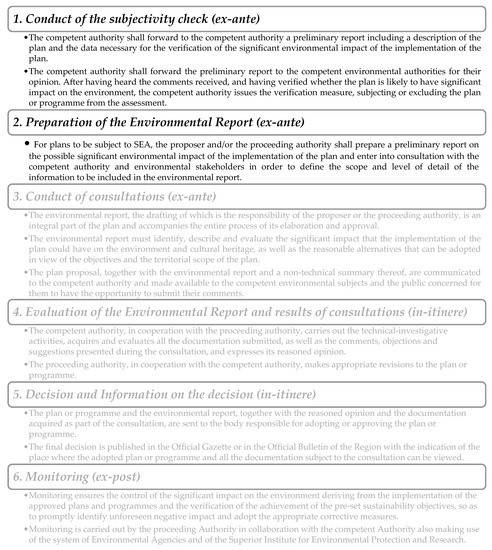
Figure 1.
Phases ongoing of the SEA process inherent to the PRG Revision of the City of Turin.
The methodology employed in this research is characterized by the multi-phase process illustrated in the flow chart in Figure 2.
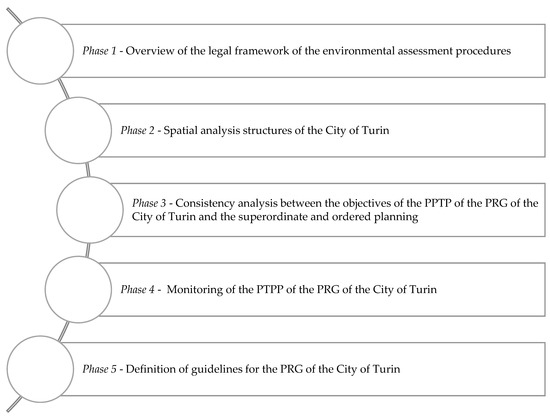
Figure 2.
Flow chart of the research methodology [29].
The first phase involved the investigation of different environmental procedures through an in-depth study of EU, Italian, and regional legislation.
The second phase included the spatial analysis of the City of Turin’s structures as a case study. In this phase, thematic maps were created using the geographical information systems (GIS) methods and consulting data from the Geoportale e governo del territorio (Geoportale e governo del territorio, http://geoportale.comune.torino.it/web/governo-del-territorio (accessed on 23 September 2022)) of the City of Turin and the GeoPortale Piemonte (GeoPortale Piemonte, https://www.geoportale.piemonte.it/cms/ (accessed on 23 September 2022)) [30,31,32] of the Piedmont Region.
The third phase concerned the consistency analysis between the objectives of the Preliminary Project Technical Proposal (Proposta Tecnica del Progetto Preliminare, hereafter called PTPP) of the PRG of the City of Turin and the superordinate and coordinated planning. To support this analysis, a study was conducted on the superordinated and coordinated planning, with specific focus on their objectives. Once the objectives were understood, they were compared with the objectives of the PTPP of the PRG through correlation matrices.
In the fourth phase, the PTPP of the PRG were monitored by considering specific indicators and the employment of GIS methods for spatial data elaboration and visualisation. This study was performed through GIS data analysis.
The last phase takes into account the previous steps and provides the design of guidelines and recommendations to address the sustainability of the revised PRG of Turin.
Research results can support the local administration in urban planning processes with a long-term vision. These provide the accompanying assessment processes with detailed analyses that provide a cognitive framework capable of synthesizing the complex nature of the City of Turin.
2.1. Data Processing, Analysing and Mapping
GIS is a computerized information system that enables the acquisition, recording, analysis, visualization, restitution, sharing, and presentation of information derived from geo-referenced data [21,33]. GIS methods can favor data processing, analysis, and mapping, and utilizes to geo-catalogs, such as the GeoPortale Piemonte and the geoportal of the City of Turin, which provides access to metadata that are continuously updated. The shapefiles considered meaningful for the research work were selected and imported to Quantum-GIS version 10.5 in order to map and process the data. The objective of the structure-based analysis (for more details, please see Section 3.1) is to provide a synthetic framework of knowledge useful for reading the factors of the territory. Performing the analysis in this manner is motivated by the completeness of the information that this type of in-depth analysis brings to light. The analysis of structures, such as environmental, settlement, social, and cultural, can deliver to decision makers a comprehensive analysis of the territory and its complex phenomena. Table 1 shows the shapefiles used for this analysis, organised by structures and the year of the last available update.

Table 1.
List of shapefiles, broken down by assets, used for analysis purposes [29].
The GIS software can also favour more fine comparisons by georeferencing, overlapping and/or combining different sets of data. This is extremely advantageous in the exploration of the complexity of the different structures as it can emphasize connections and interdependencies, both inside and outside the system under evaluation.
2.2. The Role of Socioeconomic Indicators
Strategic environmental impact assessment procedures must be supported by the integration of analysis and assessment tools that can provide decision makers quantitative, qualitative, and synthetic outcomes. In this sense, the definition and employment of indicators and indices is fundamental to processing the forecasts and outcomes of the ex ante, in itinere, and ex post phases. Firstly, such indicators and indices are parameters that provide information about a given phenomenon and whose significance goes beyond the properties directly associated with the parameter’s value [34]. Secondly, they can provide a photograph of the phenomenon fixed to a given time, and can support the prediction of alternative transformation scenarios, especially when they are included within dynamic models [17]. Indicators and indices can be powerful tool when they satisfy the following requirements [35,36]:
- -
- Scientific requirements: the indicator must have clarity of value and content, and it must be the result of an appropriate number of variables. It must be constructed in such a way as to allow a good level of knowledge of the phenomenon, providing the user with an appropriate evaluation ground on which to base choices.
- -
- Functional requirements: the indicator must be politically relevant and thus important to the stakeholders of the process; it must be interesting so that it can promote effective actions, it must not possess excessive content, and it should be aimed at the objective for which it was designed so that it can provide useful information to define actions.
- -
- Operational requirements: the indicator must be easily employed at a reasonable cost by operators; it must be designed and presented in such terms that it can be subjected to monitoring and improvements over time, it must be constructed in a timeframe that is compatible with the needs of decision makers, and it must ensure optimum social involvement. In fact, when sophisticated indicators are selected for monitoring, despite their methodological relevance, they could risk being abandoned by local operators due to a difficult calculations and monitoring, which is often the result of a lack of skills and expertise.
The indicators that were considered for this research refer to socio-economical features that were provided by the City of Turin. Indicators, such as resident population, foreign resident population, and number of households, were key to understanding the numerosity and distribution of the population within the City of Turin in specific years (2008, 2011, 2018, 2019, and 2020).
The percentage ratio of the foreign resident population was determined, with respect to the indicator resident population, to show the distribution of the inhabitants of the City of Turin. Percentage change was also calculated for the resident population and the number of households, which was necessary in order to best capture differences within the surveyed period. This percentage can be represented with the following equation:
where represents the amount of population at time t + n; represents the amount of population at time ; and represents the time interval, expressed in years.
Two indices were widely adopted to investigate the age of the population. The first was the old age index, which is the degree of aging and corresponds to the percentage ratio between the population ≥65 years of age and the population ≤14 years of age.
The second is the dependency ratio, which represents the social and economic burden of the inactive population (those ≥65 years and ≤14 years) on the active population, that is, the population aged 15–64.
Finally, the last value considered is population density, which measures the degree of crowding of an area, as the ratio between the resident population in a given area, and the total land area, which can be expressed in hectares or square kilometers.
The use of the socio-economic indicators previously described can analyse the characteristics of the social, economic, and urban dynamics of a city according to qualitative and quantitative approaches. Analytical approaches enable public administrations, managers, and citizens to react proactively to the major changes that will affect their communities [37].
2.3. Correlation Matrices
The decision-making model employs correlation matrices to explore the degree of correlation between the objectives of the PTPP and the superordinate and coordinated planning. An analysis of the different plans in force was performed to employ the correlation matrices effectively. A correlation matrix provides a comprehensive overview of potential conformities and non-conformities between the considered plans objectives, and is in the form of a table that shows the correlation of the variables to be assessed [38]. This tool has a number of advantages: it is flexible, it can be used by numerous stakeholders of different expertise, and is, in fact, the most used tool in real assessment processes. It can be characterised by a quali-quantitative approach, since it allows the combination of semaphorical and ordinal classes. Within the cells, the individual correlation indices are then shown. This tool can evaluate two types of correlations:
- Internal, when rows and columns report the same variables;
- External, i.e., the correlation evaluated in this paper, and thus between different variables.
The structure of the matrices developed in the context of the SEA process for the revision of the Municipal Plan of Turin is described as follows: the rows show the objectives of multilevel planning, while the columns show the objectives of the PTPP of the PRG Revision [29].
2.4. SEA Procedures: The Cases of the Assessment Processes behind the Municipal Plans of Turin and Bologna (Italy)
Before illustrating the results obtained by the decision-making model, a comparison of the review processes of different plans was developed, with a particular focus on the metropolitan cities of Turin and Bologna.
This comparative analysis is considered useful by the authors in order to identify commonalities and differences between SEA approaches at the national level. The comparative analysis considered, on the one hand, information concerning the City of Turin, referring to the Preliminary Report specifying the contents of the Environmental Report, and on the other hand, information about the City of Bologna, and the ValSAT Document of the General Urban Plan.
As already said, the SEA procedure was introduced in Piedmont by the Regional Law no. 40/1998 (Regional Law no. 40/1998, http://arianna.consiglioregionale.piemonte.it/base/coord/c1998040.html (accessed on 22 July 2022)), whereas in Emilia Romagna, Regional Law no. 24/2017 (Regional Law 24/2017, https://demetra.regione.emilia-romagna.it/al/articolo?urn=er:assemblealegislativa:legge:2017;24 (accessed on 22 July 2022)) introduces the Environmental and Territorial Sustainability Assessment for urban and territorial plans (ValSAT: Valutazione di Sostenibilità Ambientale e Territoriale). The ValSAT of Bologna’s PUG can therefore be retained as an inspirational example to follow during the subsequent steps of the ongoing SEA for the revision of the Municipal Plan of Turin. The ValSAT is a procedure that accompanies the elaboration of the plan, thus becoming a complementary part of it. In fact, the ValSAT can:
- -
- Contribute to the pursuit of environmental sustainability objectives;
- -
- Identify, describe and assess the relevant impact that the actions envisaged in the plan/programme could have for example on the environment, human health, cultural heritage, and landscape;
- -
- Consider and evaluate a number of reasonable alternatives that may be adopted by virtue of the environmental sustainability objectives, and provide a territorial vision of the plan/programme and the potential impact;
- -
- Ensure the monitoring of the achievement of environmental sustainability objectives, and also of the impact.
The strategy behind the revision of Turin’s PRG expresses the ambitious aim of promoting a forward-looking idea of a city capable of co-designing its long-term vision by putting the well-being of its citizens at the center by focusing on the quality of life and the urban environment in order to generate widespread prosperity and social, economic, and environmental opportunities. Thus Turin has the opportunity to regenerate itself in terms of the valorisation of its environmental, historical, architectural, and landscape heritage, without forgetting its industrial past and design, through the adaptive reuse of its’ urban fabric, in the form of business and technological incubators, research and education centres, and residential solutions. The adoption of the General Revision of the Regulatory Plan of April 2017, defined the streamlining and simplification of the regulatory apparatus as a priority.
The General Urban Plan (PUG) of Bologna was approved by the City Council and became effective on 29 September 2021. With the elaboration of the PUG, Bologna has taken up two challenges. On one hand is the challenge of innovation; of drawing up a new tool that outlines a future vision of the city, summarising the work of the Administration. On the other hand is the challenge of continuity, since the PUG constitutes the fulfillment of the contents of the previous plans (Municipal Structural Plan, Urban Building Regulations and Municipal Operational Plan), reinforcing the choice of field in favour of urban regeneration [39,40].
While the evaluation process for Turin is still ongoing, Bologna approved the new plan (2021).
Analysing, therefore, the process of the City of Bologna [41,42] favours the learning of the best practices that can be implemented within the procedure of the ongoing Revision of the PRG of Turin. The main elements of this comparison are described in the Table 2.

Table 2.
Comparison between the strategic environmental assessment procedures of Turin and Bologna.
With regard to the monitoring phase, for example, Bologna requires the periodic updating of the values of the various indicators; it establishes for each strategy a set of indicators capable of assessing the current state and evolutionary trends. As shown in the table above, it defines indicators referring to the environmental framework and also presents implementation indicators, useful for monitoring the effectiveness of urban planning. Analysis, verification of consistency, proposal of guidelines, and monitoring indicators constitute an integrated framework that must support the SEA assessment of territorial and urban plans and programmes.
3. Results
3.1. Development of Cognitive Analysis Development
To support the employment of the decision-making model, a cognitive analysis at the state of the art of the City of Turin was performed as the main case study of this research work. This analysis focused on the following structures:
- Environmental structure: morphology, hydrology, land use capacity, land use, protected (natural and built) areas, and ecological networks.
- Settlement structure: includes building fabric and infrastructure system.
- Socioeconomic structure: resident population, foreign resident population, number of households, old-age index, dependency ratio, and population density.
- Historical-cultural structure: the evolution of urban fabric; cultural heritage, UNESCO sites, such as the Savoy Royal Residences, and the Man and the Biosphere (MAB) Network and its existing itineraries [43].
3.1.1. Environmental Structure
The City of Turin is located on the plain bordered by the Po, Dora, Stura, and Sangone rivers, and has an area of about 130 square kilometers. It is also known as the “City of Four Rivers”, since these play a fundamental role in defining its identity, structuring its territorial geography, and linking different natural ecosystems. The Po River enhances the division between the hilly and flat parts of the city, located between 220 and 280 m above sea level. Figure 3, the hydrogeological vulnerability map, shows the river bands, unstable areas, floodable areas, and active landslides that characterize the City of Turin. It can be seen that the floodable areas and active landslides are located exclusively in the hilly area. While the floodable areas occur more in the northeast (in the confluence area between the Po and Stura di Lanzo rivers) and in the south (in the confluence area between the Po and Sangone rivers).
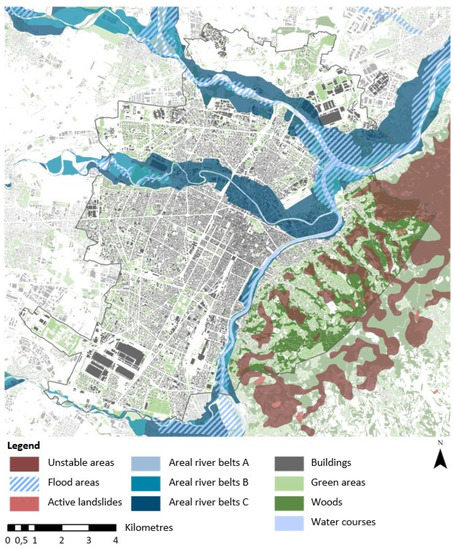
Figure 3.
Hydrogeological vulnerability map [29].
Figure 4 shows the landscape assets of the Regional Landscape Plan (Piano Paesaggistico Regionale; hereafter called PPR). It shows the regional landscape assets that are protected under Articles 136, 142, and 157 of the Cultural Heritage and Landscape Code. This representation is a reference for the application of the specific regulations dictated by the Implementation Rules of the Code. Table 3 describes the landscape assets of the City of Turin.
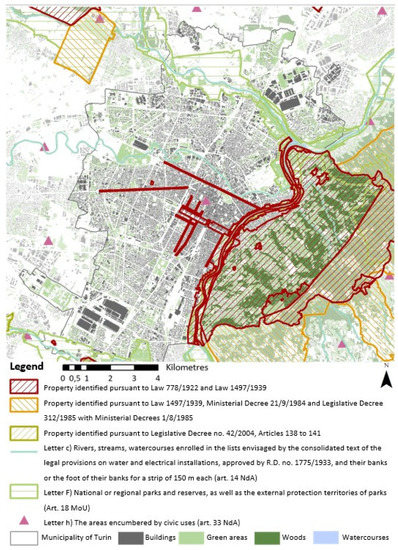
Figure 4.
Landscape assets of the regional landscape plan [29].

Table 3.
Landscape Assets of the City of Turin [29].
3.1.2. Settlement Structure
In the urban fabric of the City of Turin, buildings occupy most of the municipal area, as can be seen in Figure 5. The hillside area appears to be less built-up, due to the different elevations, which make urban expansion difficult. The predominant use is residential, which accounts for about 80% of this area. Industrial buildings, which amount to about 8% of the buildings, are mainly located in the peripheral areas to the northwest and southeast of the city. Commercial units, which amount to about 5% of the built area, are also located in the peripheral areas, while service buildings (5%) are located in both the central city and the suburbs.
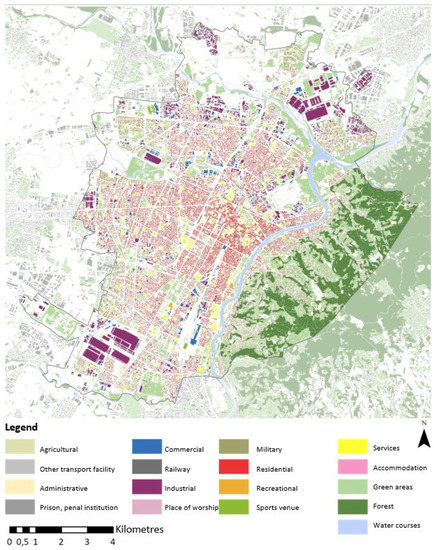
Figure 5.
Map of building use categories [29].
Regional Council Resolution No. 34-1915 (Regional Council Resolution No. 34-1915, http://www.regione.piemonte.it/governo/bollettino/abbonati/2015/35/attach/dgr_01915_660_27072015.pdf (accessed on 23 September 2022)) approved the document Monitoring Land Consumption in Piedmont-edition 2015 as a reference cognitive tool for regional policies concerning soil protection and the implementation of regional urban planning regulations, objectives, and strategies of the PTR and the PPR regarding the containment of land consumption. Soil consumption monitoring in Piedmont has become compulsory and must therefore be taken into consideration in assessment and planning processes at the regional level (Resolution No 34-1915 of 27 July 2015, http://www.regione.piemonte.it/governo/bollettino/abbonati/2015/35/siste/00000140.htm (accessed on 23 September 2022)).
The results of the analysis of the infrastructure system (see Figure 6 and Table 4) are fundamental to understand the relationships and connections inside the municipality and with its neighbors with neighboring municipalities. The theme of the road network is of significant importance in the Revision of the General Urban Plan of the City of Turin. As for the private road network, Turin has a capillary network of motorways, ring roads, provincial, and municipal roads. As for public transport, the municipal transport company, a limited company of the city of Turin, manages the local public transport service in the municipality and the metropolitan area, as well as the management of exchange parking and parking fees. Numerous public transport lines serve the entire municipal territory, including the active line 1 of the Metro. The City of Turin appears well connected thanks to the road system, these include:
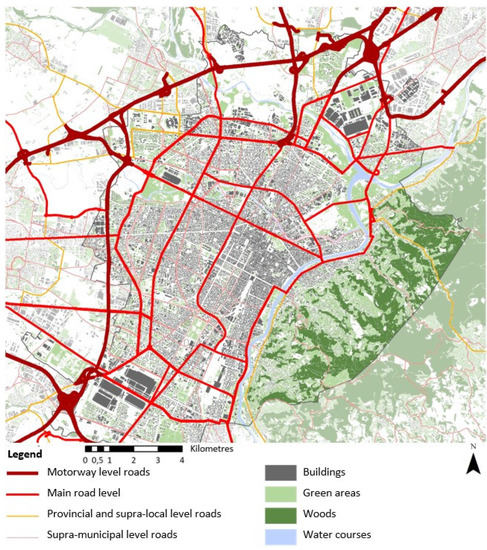
Figure 6.
Road infrastructure system. Authors’ elaboration based on data provided by the City of Turin [29].

Table 4.
Road system. Authors’ elaboration based on data provided by the City of Turin [29].
3.1.3. Socioeconomic Structure
For the analysis of the socio-economic structure, the five most synthetic and representative indicators (resident population, foreign resident population, old age index, dependency ratio, population density) are examined to understand the distribution of inhabitants in the city and the degree of dependency between the elderly and the young population.
Concerning the resident population, a comparison table containing data on the resident population of the City of Turin, the Metropolitan City, and the Piedmont Region is shown below. The values for the City of Turin are aligned to the metropolitan and regional trends. For the City of Turin, a general decrease can be observed from 2011, from 869,312 to 858,205 inhabitants in 2020 (see Table 5). Regarding the distribution of population (see Figure 7), suburban areas are characterized by higher values than central areas, due also to the presence of hilly areas.

Table 5.
Percentage changes in the resident population of the City of Turin, the Metropolitan City, and the Piedmont Region from 2011 to 2020 [44].
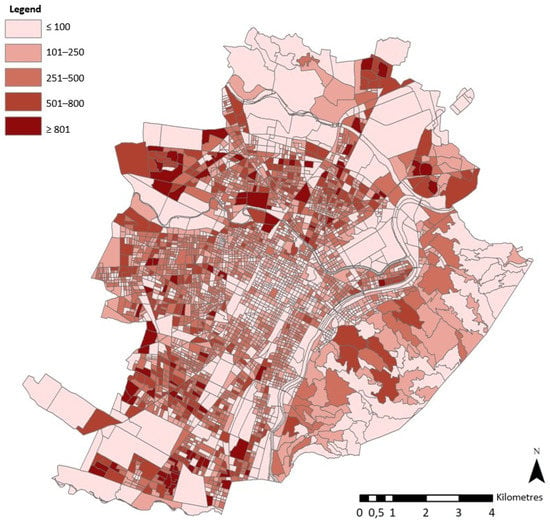
Figure 7.
Resident population, year 2020 [29].
As before, for the foreign resident population, a comparison table containing data on the resident population of the City of Turin, the Metropolitan City and the Piedmont Region is shown below. Also in this case, the values for the City of Turin reflect the metropolitan and regional trends. In general, a discontinuous trend is observed: a strong decrease between 2011 and 2012, a high increase between 2013 and 2014, and then a decrease until 2020 (see Table 6). With regards to the population distribution (see Figure 8), the peripheral areas (Lingotto, Aurora, and Barriera di Milano) are characterised by higher values than the more central areas.

Table 6.
Percentage change in the foreign resident population of the City of Turin, the Metropolitan City, and the Piedmont Region from 2011 to 2020 [44].
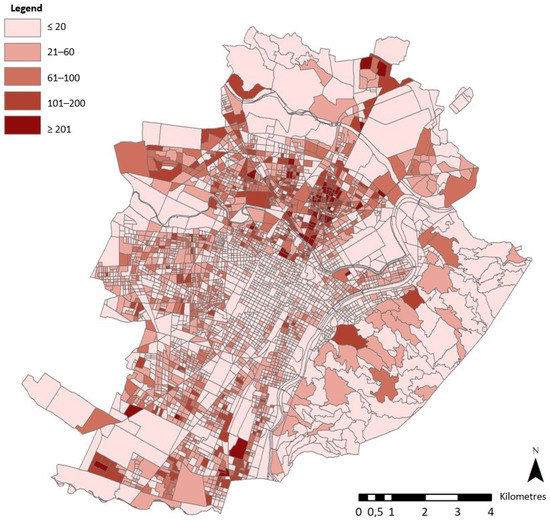
Figure 8.
Foreign resident population, year 2020 [29].
The study of the old age index is important to measure and tackle the increasingly elder population in the social, labor, and health systems. In 2011, the City of Turin was characterized by an old age index above 195 (see Table 7). This means that there were more than 195 elderly people for every 100 young people. In this case, the distribution of Figure 9 is homogeneous with respect to the entire municipal area. This trend is confirmed for all districts of the city, and it reflects regional and national values (according to Tuttitalia, the old age index of the resident population in Italy for the year 2020, was 179.3).

Table 7.
Old age index for the City of Turin, the Metropolitan City, and the Piedmont Region from 2011 to 2020 [44].
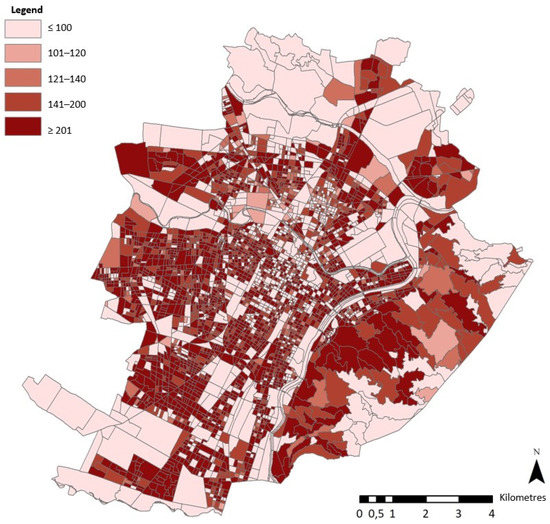
Figure 9.
Old age index, year 2020 [29].
Related to the previous index is the dependency ratio (see Figure 10), which assesses the incidence of both the elderly population and young children on the working population. Specifically, the structural dependency ratio compares the working population with the non-working population. There is a general increase in this value, both for the city of Turin and for the metropolitan and regional area (see Table 8).
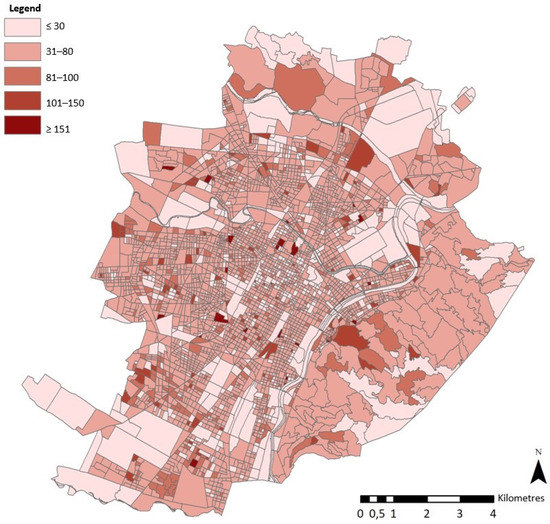
Figure 10.
Dependency ratio, year 2020 [29].

Table 8.
Dependency ratio for the City of Turin, the Metropolitan City, and the Piedmont Region from 2011 to 2020 [44].
Further insight related to the resident population is the population density (see Table 9). This index can analyse, on the one hand, the quantity of population, and on the other hand, its distribution in the municipal territory. Also in this case, municipal values reflect metropolitan and regional trends. As shown in Figure 11, except for the hilly area to the east and the peripheral area to the north, the entire area is characterised by high values of population density.

Table 9.
Population density of the City of Turin, the Metropolitan City, and the Piedmont Region from 2011 to 2020 [44]. * Pop. = population.
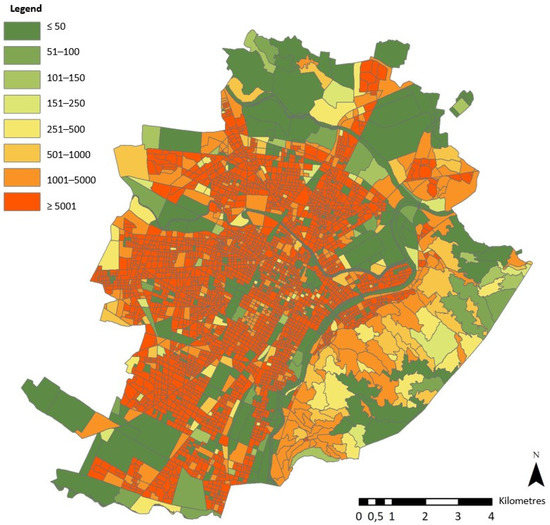
Figure 11.
Population density, 2020 [29].
3.1.4. Historical-Cultural Structure
The City of Turin counts numerous cultural assets, including:
- -
- Minor cultural sites: Castello del Drosso (900 m2).
- -
- Major cultural destinations: Villa della Regina (890 m2), Parco del Valentino (20,000 m2) e Castello del Valentino (3000 m2), Giardini Reali (9700 m2), Palazzo Reale (5900 m2), and Palazzo Madama (700 m2).
- -
- Regional destinations: Basilica di Superga (4900 m2).
Figure 12 shows the Royal Savoy Residences located in Turin. These residences have been listed as UNESCO World Heritage Sites since 1997. The sites within the municipal boundary are: Castello del Valentino, Musei Reali, Palazzo Carignano, Palazzo Madama, and Villa della Regina [45].
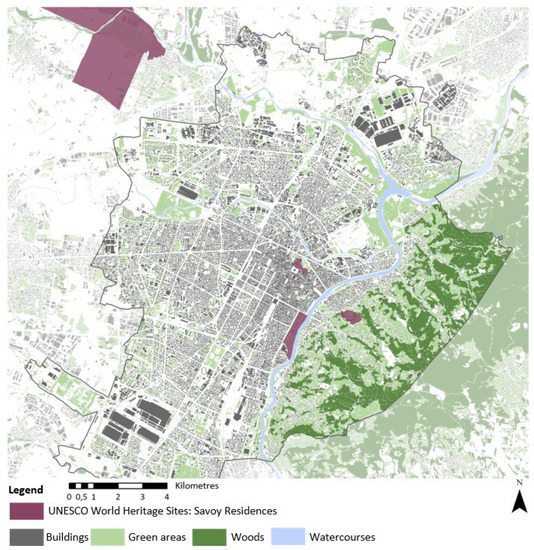
Figure 12.
Map of UNESCO World Heritage Listed Sites: the Savoy Royal Residences [29].
3.2. Consistency Analysis between the PRGC of Turin and the Other Planning Levels
The consistency analysis was made for all the plans listed in Table 10. In this article, a selection was made of the most significant consistency matrices reflecting the issues that regional and local governments are currently focusing on [45,46,47]. Correlation matrices are then created with respect to the regional territorial plan and the regional landscape plan, the metropolitan general territorial plan, and the climate resilience plan.

Table 10.
The investigated planning tools at superordinate and coordinated levels [29].
The objectives of the PTPP of the PRG Revision are reported in Table 11.

Table 11.
Strategic framework of the PTPP of the Revision of the PRG [48,49].
3.2.1. Level of Regional Planning
The regional planning of Piedmont is based on the Regional Territorial Plan (PTR) and the Landscape Regional Plan (PPR), according to the Regional Law no. 56/1977. The PTR (Regional Territorial Plan, https://www.regione.piemonte.it/web/temi/ambiente-territorio/territorio/piano-territoriale-regionale-ptr (accessed on 25 November 2022)) defines strategies for Piedmont development and growth, and entrusts their implementation to entities operating at the provincial and local levels. It establishes the actions to be taken by the various planning entities of the region, according to the principles of subsidiarity and competence, to implement the goals of the PTR. The PPR (Regional Landscape Plan, https://www.regione.piemonte.it/web/temi/ambiente-territorio/paesaggio/piano-paesaggistico-regionale-ppr (accessed on 25 November 2022)) sets the landscape at the centre of Piedmontese policies. In fact, landscape planning is cogent on the subordinated planning levels.
Both PTR and PPR plans are part of a shared planning process with the objectives of recognition, management, preservation, enhancement, and redevelopment of the regional territory. The synergy between the two plans is emphasized by a shared set of general strategies and objectives, which are articulated into specific objectives related to the specific goals of each plan. The common strategies of the PTR and PPR are listed in Table 12.

Table 12.
Strategic framework of the PTR and PPR [50,51].
For a more expedient interpretation of the matrix, it was decided to use a qualitative approach with the support of a colour scale:
- -
- High correlation: the objectives share the same strategic vision (dark green).
- -
- Moderate correlation: objectives share the same strategic vision but with a different approach (light green).
- -
- No correlation and/or discrepancy: objectives have no relationship (white).
- -
- Moderate discrepancy: objectives have different strategic visions (light red).
- -
- High discrepancy: objectives have different and contrasting strategic visions (dark red).
Obviously, the adopted approach can encounter a more quantitative approach by associating ordinal values to the considered classes. For example, this SEA process is still ongoing, therefore, the qualitative assessment is justified in this sense because at later stages it can be integrated with observations coming from the participation of actors and stakeholders actively involved with the City of Turin (e.g., at co-planning conferences once the environmental report has been delivered). This can surely support the classes attribution and a major softening action.
For example, as can be seen in the Table 13, Objective 1.1 of the shared PTR and PPR (enhancing polycentrism and the cultural and socio-economic identities of local systems) has a high correlation with Objective 2.1 of the PTPP (introduction of ecological agricultural zones (ZAE)). The ZAE are cultivated or wooded areas present in the territory, addressed to the protection and enhancement of the naturalistic characteristics of places. These areas contribute to the enhancement of the cultural, social and economic identities of the territory. Objective 1.2 of the shared PTR and PPR (safeguarding and enhancing biodiversity and the natural-environmental heritage) has a moderate discrepancy with Objective 2.2 of the PTPP (Park service areas: reclassification and redefinition of urban rules). The reclassification of parks confirms the City of Turin’s great attention on environmental enhancement issues.

Table 13.
Correlation matrix between the objectives of the PTPP of the PRG Revision and the objectives of the PTR and PPR [29].
3.2.2. Level of Metropolitan Planning
The Technical Proposal for the Preliminary Draft of the Metropolitan General Territorial Plan (Metropolitan General Territorial Plan, http://www.cittametropolitana.torino.it/cms/territorio-urbanistica/ufficio-di-piano/proposta-tecnica-preliminare-di-ptgm/proposta-tecnica-preliminare-di-ptgm (accessed on 25 November 2022)) (PTGM) was published by Decree of the Metropolitan Mayor DCRS-35-2021 dated 2 April 2021 (Decree of the Metropolitan Mayor DCRS-35-2021 dated 2 April 2021, http://www.cittametropolitana.torino.it/cms/risorse/territorio/dwd/ptgm/ptpp/DecretoDelSindaco_Vicesindaco_DCRS-35-2021.pdf (accessed on 25 November 2022)). The PTGM objectives are listed in Table 14.

Table 14.
Strategic framework of the PTGM [52].
In Table 15, Objective 1.1 of the PTGM (integration between actions for land security, adaptation to climate change, the preservation of soil, natural, and landscape resources for future generations) has high correlation with Objective 2.5 of the PTPP (inclusion of sustainability standards) and has moderate correlation with Objective 2.1 of the PTPP (introduction of ecological agricultural zones (ZAE)). The City of Turin pays great attention to the themes of soil consumption and hydraulic invariance. This focus corresponds to the aspects discussed in detail within the PTGM. Climate change, soils, and resources are key themes that are considered at all planning levels.

Table 15.
Correlation matrix between the objectives of the PTPP of the PRG Revision and the objectives of the PTGM [29].
3.2.3. Level of Local Planning
The City’s Climate Resilience Plan (Climate Resilience Plan, http://www.comune.torino.it/ambiente/cambiamenti_climatici/piano-di-resilienza-della-citta-di-torino.shtml (accessed on 25 November 2022)) detains a strategic vision that identifies the main vulnerabilities of the area and in both the short and long-term. It defines a set of actions to reduce the impact caused mainly by heat waves and flooding, as well as the exposure of the city to main climate-change-related risks (see Table 16). By City Council Resolution 2020-01683/112 of 28 July 2020 (City Council Resolution, 2020-01683/112 of 28 July 2020, https://servizi.comune.torino.it/consiglio/prg/intranet/display_testi.php?doc=T-P202001683 (accessed on 25 November 2022)), the Climate Resilience Plan was ratified by the local executive body and proposed for approval to the City Council.

Table 16.
Strategic framework of the City’s Climate Resilience Plan [53].
In Table 17, Objective 1.2 of the City’s Climate Resilience Plan (redevelopment of the urban fabric through the use of innovative materials that enable the cooling of urban pavements) has a high correlation with Objective 2.1 of the PTPP (introduction of ecological agricultural zones (ZAE)) and has a moderate correlation with Objective 3.1 of the PTPP (integration of the protection objectives of the current plan with the valorisation of industrial archaeology, 20th century architecture, and modern architecture).

Table 17.
Correlation matrix between the objectives of the PTPP of the PRG Revision and the objectives of the City’s Climate Resilience Plan [29].
The correlation matrices are suitable to verify the consistency between the objectives of the General Regulatory Plan of the City of Turin and the objectives at the municipal, metropolitan, and regional planning levels. From this analysis emerges a general consistency between the objectives of the PRG with respect to the overarching planning. The Turin PRG review, therefore, shares the visions of the coordinated and superordinated planning, and is part of a strategic framework characterised by synergistic objectives.
4. Discussion of Results
The sustainability of the new plan is addressed in more depth by a protocol of three strategies that are in turn divided into sets of actions (see Table 18). This is done in light of the studies carried out and the results reached.

Table 18.
Guidelines for the General Regulatory Plan of the City of Turin [29].
The three strategies are “Green City”, “Participatory City”, and “Resilient City”. At present, the City of Turin has a total urban green area equal to about 20% of the municipal land area. This represents an endowment of areas useful for improving the quality of life, responding to climate change and the heat island phenomenon typical of urban areas, and, finally, protecting and restoring ecosystems [54,55,56,57,58]. In addition, the consistency analysis between the PPTP’s objectives of the PRG Revision and the objectives of the coordinated planning revealed a special focus on the issue of participatory processes. An increase in transparency allows a wide range of actors and stakeholders, especially citizens, to be involved. In this way, it is possible, on the one hand, to inform them about the Public Administration decisions, and, on the other hand, to collect their needs and satisfy their interests [59]. The satisfaction of these conditions can also facilitate an increased awareness of the human impact on the environment. The strategies presented so far lead to the definition of a Resilient City, as a system capable of adapting in response to the action of a force until the achievement of a state of equilibrium different from the original [60,61,62,63,64]. Faced with the increasing complexity and uncertainty of cities, the concept of cities and/or participatory urbanism is also of great importance. In this way, projects can be improved by increasing their functionality and effectiveness, turning conflicts into a resource, while increasing civic growth and strengthening the sense of belonging to public life. The main tool to activate the process of participatory urbanism is the activation of real laboratories in which citizens can discuss and exchange information, under the guidance of facilitators (e.g., architects, or sociologists, among others) who have the task of extracting and synthesizing the contributions. This package, therefore, in addition to the outputs obtained from the decision-making model, proposes a set of guidelines useful for the attainment of the objectives defined by the PRG Review and the goals determined by the 2030 Agenda for Sustainable Development [10].
Connected to the above-mentioned themes is the concept of livability. A livable city can be conceived as a city that attempts to endow the individuals of specific communities with a strong sense of satisfaction and well-being, through the incorporation and enhancement of existing environmental, geospatial, and social characteristics and structures, through infrastructure planning, reducing the population density within each community, improving the aesthetics of the surrounding environment, accessibility, and ensuring the provision of primary needs and facilities, as well as making use of peripheral lands during urban planning processes [65]. The formation of more livable cities requires the global cooperation of different governments and multi-level organizations. The promotion of good health and well-being, the response to climate change, and the creation of a harmonious living environment for human settlements are now internationally shared objectives to which municipal planning must provide a strategy [66]. One of the key conditions for accelerating change is the establishment of green cities [67,68]. The emerging issue of nature-based solutions (NBS) represents the latest “greening” trend to support sustainable spatial planning. It is a relatively recent concept used by the European Commission to identify strategies, actions, and interventions based on nature that ensure environmental services and socio-economic benefits that are capable, when carried out in an urban context, to increase the resilience of cities [69]. Their implementation can generate multiple benefits for health, the economy, society, and the environment, and therefore can represent more efficient and economic solutions than traditional approaches, provided that they are suitable for the territories of their realization. NBSs can provide multiple services in favour of biodiversity and human well-being, aimed at responding effectively to current challenges, such as climate change, food security, or environmental risks mitigation. NBSs essentially can refer to an increase, improvement, and enhancement of green areas, to the production of ecosystem services (ESs), such as the improvement of air quality (intercepting dust and other air pollutants), regulation of the urban microclimate, containment of the heat island in the city, regulation of meteoric water flows, provision of leisure/recreation opportunities, conservation of biodiversity, and the absorption of greenhouse gases, among others [69].
5. Conclusions
This research has developed a methodology to support the SEA procedure of urban plans and programmes and thus favoring a coherent and sustainable development process. The cognitive analysis of the major planning structures was fundamental to establish a comprehensive knowledge of the municipality from which the PRG Revision will generate its effects over time [70,71,72]. The verification of internal and external consistency, through the use of correlation matrices, allows for the identification of similarities and discrepancies between the objectives of the plan and the objectives of regional, metropolitan, and local planning. In front of potential inconsistencies, these matrices can support the public administration in finding suitable solutions for the modification and adaptation of the objectives of the new plan. The proposed guidelines can be extrapolated from the analysis of the results in this work. The contents and methodologies proposed are, therefore, part of the procedure shared with the City of Turin to provide a framework for the elaboration of the assessment documents supporting municipal planning. The consistency analysis has demonstrated a substantial consistency and sustainability of the objectives of the Technical Proposal of the Preliminary Draft of the Revision of the General Regulatory Plan. Currently, with regards to the ongoing SEA procedure, Turin’s PRG is at the stage of preparing the environmental report.
The comparative analysis between the SEA procedures of the cities of Turin and Bologna identified several similarities, which favour the replicability of the method. Both procedures provide (i) an analysis of the context behind general framework, (ii) the verification of consistency between the objectives of the plan and the objectives of regional, metropolitan, and local planning, (iii) the proposal of guidelines and recommendations useful for the verification and possible integration of strategies, and (iv) a framework for monitoring the effects of the plan.
Possible Future Research Directions
In the light of the results obtained, possible future developments can be extrapolated from this research work. The authors intend to monitor the ongoing PRG Revision through the use of indices that can be used to support the governance and implementation of the plan, assess the level to which it is achieving it’s objectives (short, medium, and long term), and analyse and evaluate the environmental effects of the implementation of the plan. Therefore, the next step of this research in terms of a future study is to establish indicators and indices that can be used to monitor of the effects of the PRG and its policies in terms of the prosperity, equality, opportunity, and well-being for all that result from its implementation. Two indicators are proposed in this research that can be useful to monitor the effects of the plan over time: permeability (%) and land consumption (ha).
The permeable surface (SP) is defined as the portion of land area that is free of pavement or other permanent structures, within or above ground, that prevent stormwater from naturally reaching the water table. It measures the percentage ratio (%) between the portion of soil with and without pavement and/or other permanent structures within the territorial area [73].
Another useful index to monitor the permeability of soils is the curve number (CN): an inflow-deflow method that estimates excess precipitation as a function of cumulative rainfall, land cover, land use and antecedent moisture. The values taken by the CN can vary between 1, for permeable soils with high infiltration rate, and 100, for soils with reduced infiltration rate, which are therefore impermeable [74].
Piedmont Region defines land use as follows: “a dynamic process that alters the nature of a land area from natural to artificial conditions, of which sealing represents the last stage” [75,76]. Some catalogs and databases grant access to the outcomes of monitoring work, one of which is the National System for Environmental Protection [77]. The analysis of the territory in terms of land use, land cover, and land consumption enables a monitoring of the evolution of the phenomena of land consumption and land transformations [78]. Turning then to a quantitative analysis, for the City of Turin, there is a steady increase in the percentage of consumed land in the administrative area from 2012 to 2020. Thus, analyzing the values shown in Table 19, the growth of land use has increased by about 62 hectares in eight years.

Table 19.
Land Consumption [77,78,79].
Thus, the decision-making model can be considered a suitable accompaniment to the stages of the SEA of the Revision of the PRG of the City of Turin, with regard to the specification of the contents of the environmental report. This method can also employed for future revisions of the plan itself, and it can also be replicated for the revision of other local plans in Piedmont’s municipalities. This methodology can, therefore, be addressed to public administrators and to technicians who have to carry out the SEA procedures of urban and territorial plans. To accommodate this, one of the most important components that every smart city should possess is a multi-scale big data information system for collecting, updating, and analysing data at the national, provincial, city, neighbourhood, and individual levels [80,81,82]. Future governance, supported by public administration technicians and experts, must therefore aim towards the valorisation and sharing of datasets. The design and definition of the latter is often constrained by bureaucratic procedures related to licenses and data sharing availability [83,84]. The public administration must, therefore, provide regular updates, an extension of the content with higher levels of detail, the evaluation of data quality, the ordering of licenses in the different regions, and the creation of a community that supports the improvement and reuse of the database.
Author Contributions
The authors contributed equally to all the parts of the paper: Conceptualization, G.S., V.A., M.C.B. and G.M.; methodology, G.S., V.A., M.C.B. and G.M.; software, G.S., V.A., M.C.B. and G.M.; validation, G.S., V.A., M.C.B. and G.M.; investigation, G.S., V.A., M.C.B. and G.M.; data curation, G.S., V.A., M.C.B. and G.M.; writing—original draft preparation, G.S., V.A., M.C.B. and G.M.; writing—review and editing, G.S., V.A., M.C.B. and G.M.; visualization, G.S., V.A., M.C.B. and G.M.; supervision, V.A., M.C.B. and G.M. All authors have read and agreed to the published version of the manuscript.
Funding
This research received no external funding.
Institutional Review Board Statement
Not applicable.
Informed Consent Statement
Not applicable.
Data Availability Statement
Not applicable.
Acknowledgments
Part of this research work was developed as part of the Master Degree’s Thesis entitled “The revision of the General Municipal Regulatory Plan of the City of Turin. Analysis and guidelines in support of the Strategic Environmental Assessment” by G. Sugoni (Politecnico di Torino, Supervisors: G. Mondini, M. Bottero, and V. Assumma). Many thanks are also due to Donato Gugliotta, Wassel Labed, and Cristina Vaccaro of the City of Turin for their support during G. Sugoni’s internship work at the municipal offices in the context of the SEA of the Revision of the PRG of the City of Turin.
Conflicts of Interest
The authors declare no conflict of interest.
References
- United Nations. Report of the World Commission on Environment and Development: Our Common Future; United Nations: San Francisco, CA, USA, 1987. [Google Scholar]
- Crutzen, P.J. Benvenuti nell’Antropocene. L’uomo ha Cambiato il Clima, la Terra Entra in Una Nuova Era; Mondadori: Milano, Italy, 2005. [Google Scholar]
- Mondini, G. Valutazioni di sostenibilità: Dal rapporto Brundtland ai Sustainable Development Goal. Valori E Valutazioni Fasc. 2019, 23, 129–138. [Google Scholar]
- United Nations. Report of the Secretary-General on the Work of the Organization; United Nations: San Francisco, CA, USA, 2022. [Google Scholar]
- Blakely, E.J. Urban Planning for Climate Change; Lincoln Institute of Land Policy: Cambridge, MA, USA, 2007. [Google Scholar]
- Condon, P.M.; Cavens, D.; Miller, N. Urban Planning Tools for Climate Change Mitigation; Lincoln Institute of Land Policy: Cambridge, MA, USA, 2009. [Google Scholar]
- Wamsler, C.; Brink, E.; Rivera, C. Planning for climate change in urban areas: From theory to practice. J. Clean. Prod. 2013, 50, 68–81. [Google Scholar] [CrossRef]
- Ward, S. Planning and Urban Change Planning and Urban Change; Sage Publications: New York, NY, USA, 2004; pp. 1–320. [Google Scholar]
- Brundtland, G.H. Our common future—Call for action. Environ. Conserv. 1987, 14, 291–294. [Google Scholar]
- United Nations. The 2030 Agenda for Sustainable Development; United Nations: San Francisco, CA, USA, 2015. [Google Scholar]
- Mondini, G.; Bottero, M.C. Valutazione e sostenibilità. In Piani, Programmi, Progetti; Celid: Torino, Italy, 2009. [Google Scholar]
- Ellen Macarthur Foundation. Towards the circular economy. J. Ind. Ecol. 2013, 2, 23–44. [Google Scholar]
- Ghisellini, P.; Ulgiati, S. Managing the Transition to the Circular Economy In Handbook of the Circular Economy; Edward Elgar Publishing: Cheltenham, UK, 2020; pp. 491–504. [Google Scholar]
- Holling, C.S. Engineering Resilience versus Ecological Resilience. In Engineering within Ecological Constraints; Schulze, P.E., Ed.; National Academy Press: Washington, DC, USA, 1996; pp. 31–43. [Google Scholar]
- Pietrantoni, L.; Prati, G. Resilience among First Responders; CLUEB: Bologna, Italy, 2009; Volume 8, pp. 1000–1019. [Google Scholar]
- Assumma, V.; Bottero, M.; De Angelis, E.; Lourenço, J.M.; Monaco, R.; Soares, A.J. A decision support system for territorial resilience assessment and planning: An application to the Douro Valley (Portugal). Sci. Total Environ. 2021, 756, 143806. [Google Scholar] [CrossRef]
- Assumma, V.; Caprioli, C.; Datola, G. Nuovi strumenti e prospettive per la valutazione delle città e dei territori del futuro. In Nuovi Strumenti e Prospettive Per la Valutazione Delle Città e Dei Territori del Futuro; All’Insegna del Giglio: Firenze, Italy, 2022; pp. 265–270. [Google Scholar]
- Brunetta, G.; Ceravolo, R.; Barbieri, C.A.; Borghini, A.; de Carlo, F.; Mela, A.; Beltramo, S.; Longhi, A.; De Lucia, G.; Ferraris, S. Territorial Resilience: Toward a Proactive Meaning for Spatial Planning. Sustainability 2019, 11, 2286. Available online: https://iris.polito.it/retrieve/handle/11583/2731012/441261/Territorial%20Resilience%20in%20Sustainability%20GB%20R3C%202019.pdf (accessed on 27 January 2023). [CrossRef]
- Cutter, L. Resilience to What? Resilience for Whom? Geogr. J. 2016, 182, 110–113. [Google Scholar] [CrossRef]
- Meerow, S.; Newell, J.P.; Stults, M. Defining urban resilience: A review. Landsc. Urban Plan. 2016, 147, 38–49. [Google Scholar] [CrossRef]
- Malczewski, J. GIS-Based Multicriteria Decision Analysis: A Survey of the Literature. Int. J. Geogr. Inf. Sci. 2006, 20, 703–726. [Google Scholar] [CrossRef]
- Yeh, A.G. Urban planning and GIS. Geogr. Inf. Syst. 1999, 2, 877–888. [Google Scholar]
- Città di Torino. Deliberazione del Consiglio Comunale (Proposta Dalla G.C. 13 Aprile 2017). Available online: https://geoportale.comune.torino.it/web/sites/default/files/mediafiles/2017_01354.pdf (accessed on 25 November 2022).
- Direttiva 85/337/CEE del Consiglio del 27 Giugno 1985 Concernente la Valutazione Dell’impatto Ambientale di Determinati Progetti Pubblici e Privati. Available online: https://eur-lex.europa.eu/legal-content/EN/TXT/?uri=CELEX%3A31985L0337 (accessed on 27 January 2023).
- Legge 8 luglio 1986, n. 349, Istituzione del Ministero Dell’ambiente e Norme in Materia di Danno Ambientale. Available online: https://www.normattiva.it/uri-res/N2Ls?urn:nir:stato:legge:1986-07-08;349!vig= (accessed on 27 January 2023).
- Direttiva 2001/42/CE del Parlamento Europeo e del Consiglio, del 27 Giugno 2001, Concernente la Valutazione Degli Effetti di Determinati Piani e Programmi Sull’ambiente. Available online: https://eur-lex.europa.eu/legal-content/IT/ALL/?uri=celex%3A32001L0042 (accessed on 27 January 2023).
- Bottero, M.; Datola, G.; De Angelis, E.; Mondini, G. Experimenting System Dynamics Model to Assess the Impacts of Urban Regeneration Processes. In Values, Cities and Migrations (Green Energy and Technology); Napoli, G., Mondini, G., Oppio, A., Rosato, P., Barbaro, S., Eds.; Springer: Berlin/Heidelberg, Germany, 2023. [Google Scholar] [CrossRef]
- Caprioli, C.; Bottero, M.; Zanetta, E.; Mondini, G. Ecosystem Services in Land-Use Planning: An Application for Assessing Transformation Scenarios at the Local Scale. In New Metropolitan Perspectives; NMP 2020. Smart Innovation, Systems and Technologies; Bevilacqua, C., Calabrò, F., Della Spina, L., Eds.; Springer: Berlin/Heidelberg, Germany, 2021; Volume 178. [Google Scholar] [CrossRef]
- Sugoni, G. The Revision of the Municipal General Regulatory Plan of the City of Turin. Analysis and guidelines to support Strategic Environmental Assessment. Master’s Thesis, Polytechnic of Turin, Turin, Italy, 2022. [Google Scholar]
- Geoportale e Governo del Territorio. Available online: https://geoportale.comune.torino.it/web/governo-del-territorio (accessed on 25 November 2022).
- GeoPortale Piemonte. Available online: https://www.geoportale.piemonte.it/cms/ (accessed on 25 November 2022).
- Geoportale Torino. Available online: https://geoportale.comune.torino.it/web/ (accessed on 25 November 2022).
- Maes, J.; Egoh, B.; Willemen, L.; Liquete, C.; Vihervaara, P.; Schägner, J.P.; Grizzetti, B.; Drakou, E.G.; La Notte, A.; Zulian, G. Mapping ecosystem services for policy support and decision making in the European Union. Ecosyst. Serv. 2012, 1, 31–39. [Google Scholar] [CrossRef]
- OECD. OECD Environmental Indicators. Development, Measurement and Use. 2003. Available online: https://www.oecd.org/environment/indicators-modelling-outlooks/24993546.pdf (accessed on 27 January 2023).
- Jesinghaus, J. On the Art of Aggregating Apples & Oranges; Fondazione Eni Enrico Mattei: Venice, Italy, 2000. [Google Scholar]
- Vallega, A. Indicatori per il Paesaggio. FrancoAngeli. 2008. Available online: https://books.google.it/books?id=iIFCidgV_ksC&printsec=frontcover&hl=it#v=onepage&q&f=false (accessed on 25 November 2022).
- Antonucci, G.; Barile, M.; Biondi, V.; Centrone, B.; Cataldo, U.; De, C.; De Santis, F.; Lecci, P.; Lovecchio, R.; Simone, F. Modelli Matematici per L’analisi delle Città: Approcci per le Smart City. 2013. Available online: http://www.mifav.uniroma2.it/inevent/events/pcst_sce_2013/docs/III_3.pdf (accessed on 27 January 2023).
- Leopold, L.B.; Clarke, F.; Hanshaw, B.; Balsey, J. A Procedure for Evaluating Environmental Impact; US Department of the Interior: Washington, DC, USA, 1971.
- De Luca, C.; Tondelli, S.; Martin, J. Ecosystem Services Integration into Local Policies and Strategies in the City of Bologna: Analysis of the State of the Art and Recommendations for Future Development. In Ecosystem Services and Green Infrastructure Perspectives from Spatial Planning in Italy; Springer: Berlin/Heidelberg, Germany, 2021; pp. 127–139. [Google Scholar]
- Vignoli, F.; De Luca, C.; Tondelli, S. A Spatial Ecosystem Services Assessment to Support Decision and Policy Making: The Case of the City of Bologna. Sustainability 2021, 13, 2787. [Google Scholar] [CrossRef]
- Città di Bologna, Piano Urbanistico Generale, Documento di VALSAT. 2021. Available online: https://sit.comune.bologna.it/alfresco/d/d/workspace/SpacesStore/729fe42d-e07b-4bf8-a0fe-d6bd366fcc4f/DocumentoValsat_APPRweb.pdf (accessed on 27 January 2023).
- Città di Bologna, Piano Urbanistico Generale, Settembre 2021. Available online: https://dru.iperbole.bologna.it/pianificazione?filter=Piano%20Urbanistico%20Generale%20(PUG) (accessed on 27 January 2023).
- Unesco. Collina Po (Piemonte). 2022. Available online: https://www.unesco.it/it/RiserveBiosfera/Detail/96 (accessed on 25 November 2022).
- Tuttitalia.it. Statistiche Demografiche Italia. Consulted 30 September 2022. Available online: https://www.tuttitalia.it/statistiche/ (accessed on 25 November 2022).
- Assumma, V.; Druetto, D.; Garnero, G.; Mondini, G. A Model of Analysis and Assessment to Support the Valorisation and Management of Green Areas; The Royal Gardens of Turin: Torino, Italy, 2021. [Google Scholar] [CrossRef]
- Bram, F. Strategic environmental assessment quality assurance: Evaluating and improving the consistency of judgments in assessment panels. Environ. Impact Assess. Rev. 2004, 24, 3–25. [Google Scholar]
- Declerck, M.; Trifonova, N.; Black, J.; Hartley, J.; Scott, B.E. A new strategic framework to structure Cumulative Impact Assessment (CIA). Int. Mar. Energy J. 2022, 5, 339–347. [Google Scholar] [CrossRef]
- Città di Torino, Proposta Tecnica del Progetto Preliminare, Rapporto Preliminare di Specificazione dei Contenuti del Rapporto Ambientale, Maggio 2020. Available online: https://geoportale.comune.torino.it/web/sites/default/files/mediafiles/1.1_rapporto_preliminare_di_specificazione_dei_contenuti_del_rapporto_ambientale_0.pdf (accessed on 25 November 2022).
- Città di Torino, Proposta Tecnica del Progetto Preliminare, Relazione Illustrativa Generale, Scheda Quantitativa dei Dati Urbani, Luglio 2020. Available online: https://geoportale.comune.torino.it/web/sites/default/files/mediafiles/2_relazione_illustrativa_generale_e_scheda_quantitativa_dati_urbani_bis_tc.pdf (accessed on 25 November 2022).
- Regione Piemonte, Piano Territoriale Regionale 2011. Available online: https://www.regione.piemonte.it/web/temi/ambiente-territorio/territorio/piano-territoriale-regionale-ptr (accessed on 25 November 2022).
- Regione Piemonte, Piano Paesaggistico Regionale 2017. Available online: https://www.regione.piemonte.it/web/temi/ambiente-territorio/paesaggio/piano-paesaggistico-regionale-ppr (accessed on 25 November 2022).
- Città Metropolitana di Torino, Piano Territoriale Generale Metropolitano, Proposta Tecnica di Progetto Preliminare 2021. Available online: https://www.torinometropoli.it/cms/territorio-urbanistica/ufficio-di-piano/proposta-tecnica-preliminare-di-ptgm/proposta-tecnica-preliminare-di-ptgm (accessed on 25 November 2022).
- Città di Torino, Piano di Resilienza Climatica 2020. Available online: https://www.comune.torino.it/ambiente/cambiamenti_climatici/piano-di-resilienza-della-citta-di-torino.shtml (accessed on 25 November 2022).
- Giaimo, C.; Regis, D.; Salata, S. Ecosystem services and urban planning. Tools, methods and experiences for an integrated and sustainable territorial government. NEWDIST 2016, 296–308. Available online: https://iris.polito.it/retrieve/handle/11583/2673525/153356/Giaimo-Regis-Salata_SBE_NewDist_2016.pdf (accessed on 27 January 2023).
- Giaimo, C.; Salata, S. Rigenerazione urbana e buon uso del suolo: Mappare e valutare i servizi ecosistemici alla scala locale. Esperienze dal Progetto Life Sam4cp. Work. Pap. 2017, 1–14. [Google Scholar]
- Salata, S.; Strollo, A.; Barbieri, C.A.; Giaimo, C.; Assennato, F.; Abate Daga, I. Modelli urbanistici per ridurre il consumo di suolo: Il Progetto Life SAM4CP. Reticula 2017, 15, 10–17. [Google Scholar]
- Salata, S.; Giaimo, C.; Alberto Barbieri, C.; Garnero, G. The utilization of ecosystem services mapping in land use planning: The experience of LIFE SAM4CP project. J. Environ. Plan. Manag. 2019, 63, 523–545. [Google Scholar] [CrossRef]
- Caldarice, O.; Salata, S. Valutare i Servizi Ecosistemici nel Piano come Risposta alla Vulnerabilità Territoriale. Una Riflessione Metodologica a partire dalla Proposta di Legge sul Consumo di Suolo in Piemonte. Valori Valutazioni 2019, 22, 67–83. [Google Scholar]
- Floris, M.; Leccis, F. Challenges in the Implementation of the 2030 Agenda at the Local Scale. The Case Study of the Municipal Masterplan of Cagliari. In Proceedings of the Computational Science and Its Applications—ICCSA 2022 Workshops, Malaga, Spain, 4–7 July 2022; Springer International Publishing: Berlin/Heidelberg, Germany, 2022; pp. 19–30. [Google Scholar]
- White, I.; O’Hare, P. From rhetoric to reality: Which resilience, why resilience, and whose resilience in spatial planning? Environ. Plan. C Gov. Policy 2014, 32, 934–950. [Google Scholar] [CrossRef]
- Sturiale, L.; Scuderi, A. The role of green infrastructures in urban planning for climate change adaptation. Climate 2019, 7, 119. [Google Scholar] [CrossRef]
- Allen, M.R.; Babiker, M.; Chen, Y.; Coninck, H.D.; Connors, S.; Diemen, R.V.; Dube, O.P.; Ebi, K.L.; Engelbrecht, F.; Ferrat, M.; et al. Summary for Policymakers; IPCC: Geneva, Switzerland, 2018; Available online: https://www.ipcc.ch/sr15/chapter/spm/ (accessed on 27 January 2023).
- Levy, J.M. Contemporary Urban Planning; Pearson/Prentice Hall: Upper Saddle River, NJ, USA, 2009. [Google Scholar]
- Dell’Anna, F.; Pederiva, G.; Vergergio, G.; Becchio, C.; Bottero, M. Supporting sustainability projects at neighbourhood scale: Green visions for the San Salvario district in Turin guided by a combined assessment framework. J. Clean. Prod. 2023, 384, 135460. [Google Scholar] [CrossRef]
- The United Nations. United Nations Conference on Human Settlements: Habitat II. 1996. Available online: https://www.un.org/en/conferences/habitat/istanbul1996 (accessed on 27 January 2023).
- Chi, Y.L.; Mak, H.W.L. From Comparative and Statistical Assessments of Liveability and Health Conditions of Districts in Hong Kong towards Future City Development. Sustainability 2021, 13, 8781. [Google Scholar] [CrossRef]
- Esmail, B.A.; Cortinovis, C.; Suleiman, L.; Albert, C.; Geneletti, D.; Mörtberg, U. Greening cities through urban planning: A literature review on the uptake of concepts and methods in Stockholm. Urban For. Urban Green. 2022, 72, 127584. [Google Scholar] [CrossRef]
- Stobbelaar, D.; Knaap, W.; Spijker, J. Transformation towards Green Cities: Key Conditions to Accelerate Change. Sustainability 2022, 14, 6410. [Google Scholar] [CrossRef]
- European Commission, Directorate-General for Research and Innovation. Towards an EU Research and Innovation Policy Agenda for Nature-Based Solutions & Re-Naturing Cities: Final Report of the Horizon 2020 Expert Group on ‘Nature-Based Solutions and Re-naturing Cities’: (Full Version); Publications Office: Luxembourg, 2015; Available online: https://data.europa.eu/doi/10.2777/479582 (accessed on 27 January 2023).
- Adams, D. Urban Planning and the Development Process; Routledge: Milton Park, UK, 2012. [Google Scholar]
- Naess, P. Urban planning and sustainable development. Eur. Plan. Stud. 2001, 9, 503–524. [Google Scholar] [CrossRef]
- Oliveira, V.; Pinho, P. Evaluation in urban planning: Advances and prospects. J. Plan. Lit. 2010, 24, 343–361. [Google Scholar] [CrossRef]
- Città di Torino, Regolamento Edilizio. 2021. Available online: http://www.comune.torino.it/regolamenti/302/302.htm (accessed on 25 November 2022).
- Pastorello, M. Methodological Proposals for a Regulation of Hydraulic and Hydrological Invariance in the Territory of Turin. Master’s Thesis, Polytechnic of Turin, Turin, Italy, 2019. [Google Scholar]
- Regione Piemonte. Monitoraggio Del Consumo di Suolo in Piemonte; Regione Piemonte: Torino, Italy, 2015. [Google Scholar]
- Deliberazione della Giunta Regionale 27 luglio 2015, n. 34-1915, Approvazione del Documento “Il Monitoraggio del Consumo di Suolo in Piemonte-Edizione 2015”. Available online: https://www.regione.piemonte.it/governo/bollettino/abbonati/2015/35/attach/dgr_01915_660_27072015.pdf (accessed on 27 January 2023).
- SNPA. Rapporto Annuale Sulle Attività Del Sistema Nazionale a Rete Per la Protezione Dell’ambiente. 2020. Available online: https://documenti.camera.it/_dati/leg18/lavori/documentiparlamentari/indiceetesti/237/004_RS/INTERO_COM.pdf (accessed on 27 January 2023).
- Sistema Nazionale per la Protezione dell’Ambiente, Database Indicatori Consumo di Suolo in Italia. Available online: https://webgis.arpa.piemonte.it/secure_apps/consumo_suolo_agportal/?entry=5 (accessed on 27 January 2023).
- Sistema Nazionale per la Protezione dell’Ambiente, SINAnet, Dataset degli Indicatori, Carta Nazionale del Consumo di Suolo. Available online: https://groupware.sinanet.isprambiente.it/uso-copertura-e-consumo-di-suolo/library/consumo-di-suolo/ (accessed on 27 January 2023).
- Mak, H.W.L. From COVID-19 Pandemic of Five Selected East Asian Cities to Assessment of Data Openness and Integration for Future City Development; Joint Lab on Future Cities (JLFC): Hong Kong, China, 2021. [Google Scholar]
- Zhou, C.; Su, F.; Pei, T.; Zhang, A.; Du, Y.; Luo, B.; Cao, Z.; Wang, J.; Yuan, W.; Zhu, Y.; et al. COVID-19: Challenges to GIS with Big Data. Geogr. Sustain. 2020, 1, 77–87. [Google Scholar] [CrossRef]
- Cecchini, A.; Blecic, I. Verso una pianificazione antifragile: Come pensare al futuro senza prevederlo. In Verso Una Pianificazione Antifragile; Franco Angeli: Milan, Italy, 2016; p. 191. [Google Scholar]
- Kepka, M.; Hájek, P.; Kožuch, D.; Řezník, T.; Mildorf, T.; Charvát, K.; Kepka Vichrová, M.; Chytrý, J. An Advanced Open Land Use Database as a Resource to Address Destination Earth Challenges. Land 2022, 11, 1552. [Google Scholar] [CrossRef]
- Service, J.; Lajous, L.; Robbins-Prnniman, S. Web-based, Multi-platform, Centralized, Offline-Compatible Supply Chain Management System for Emergency Responses. In Proceedings of the IEEE Global Humanitarian Technology Conference (GHTC), Seattle, WA, USA, 13–16 October 2016; IEEE: Piscataway, NJ, USA, 2023. [Google Scholar]
Disclaimer/Publisher’s Note: The statements, opinions and data contained in all publications are solely those of the individual author(s) and contributor(s) and not of MDPI and/or the editor(s). MDPI and/or the editor(s) disclaim responsibility for any injury to people or property resulting from any ideas, methods, instructions or products referred to in the content. |
© 2023 by the authors. Licensee MDPI, Basel, Switzerland. This article is an open access article distributed under the terms and conditions of the Creative Commons Attribution (CC BY) license (https://creativecommons.org/licenses/by/4.0/).